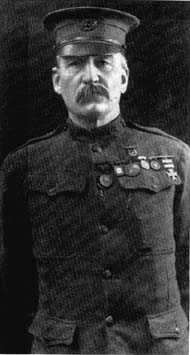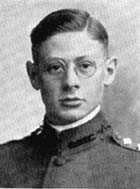Resource Center
On-Line Library


SERGEANT W. J.
ALLEN, |
|

CADET
COLONEL |
252
![]()

History of the Military Department
The department of Military Science and Tactics of the University of Nebraska is one of the oldest departments in the University. It was established by authority of a Congressional act of 1863, in which certain portions of the public domain were set aside as endowments in favor of those schools whose curricula included military drill. This act induced the University of Nebraska to establish drill, and the income from Nebraska's lands amounts to $42,000 per annum. It is stated that if Nebraska's land had been properly cared for, the above income would be nearly doubled. In addition to the financial arrangement, the instructor, an officer of the regular army, is furnished to the school without cost.
In 1876 the military department was organized with a Lieut. E. S. Dudley as commandant. The first unit organized, Company A, was composed of fifty men armed with old 50-calibre rifles. Late in the year a review for the regents was held, but as a military spectacle it was a failure. To improve appearances, uniforms, which consisted principally of brass buttons and epaulettes, were adopted. Many of the cadets objected to the infringements on their personal liberty, as they considered it, and of the objectors a new company was formed.
Lieut. I. T. Webster succeeded Lieutenant Dudley in 1879. Under his direction the cadet band was formed, At this time several states were grouped together to share one commandant in common, and after three years here Lieutenant Webster left for work with the states of Iowa and Minnesota.
In 1882 Lieutenant Townley, of the navy, was detailed here as commandant, and under his supervision the uniforms assumed naval insignia and appearance.
After two years' absence Lieutenant Dudley was reappointed as instructor at the University of Nebraska. Under his direction the military department expanded and was greatly improved. It was through his efforts that the armory was built, that new companies were formed, and that annual encampments (discontinued in 1913) were instituted. Also by this man's work the cadet officers, upon graduation, received commissions in the reserve National Guard - a practice that is still followed. It was during this period that the co-eds succumbed to th(e) appeal of the uniform and the University saw the rise of a woman's company. Neat and trim uniforms were adopted, and by the consent of the commandant, the girls enjoyed the military privileges of drilling in dust and mud and of carrying a blunderbus. As slayers of men, in a military sense, the company was not a success, and in less than one year from the date of organization it was disbanded by mutual consent.
Succeeding Lieutenant Dudley was an officer named Lieut. Thomas W. Griffith. He came in 1888 and held the position of commandant for four years.
In the fall of the year of 1891 General John J. Pershing (then a lieutenant) was detailed here as commandant. He was a disciplinarian and it was he who introduced the demerit system. By him the band, which had baffled the efforts of former commandants, was transformed into a somewhat military organization. At the end of the first year General Pershing took Company A to Omaha, and in a competition open to the United States, won first place with a prize of $1500 and a silver cup. This is the cup that the companies compete for at the annual competitive drill. New rifles and accoutrements were secured by Pershing, and by him a troop of cavalry and a battery of artillery were organized. During General Pershing's four years here the number of men taking drill was more than doubled, and so well known became the cadets that a series of views of the United States Military Academy
![]()

was received from the commandant of that institution with the inscription "From the best drilled cadet corps in the United States to the second best." It is interesting to know, and not out of place to mention here, that General Pershing is a graduate of Nebraska University, having studied law here and receiving the degree of LL.B.
Capt. J. T. Guilfoyle was detailed to the University in 1895, and was commandant for three years. Lieutenant Stotsenberg relieved him in 1898, but Lieutenant Stotsenberg was removed as was Captain Guilfoyle, for duty in the Spanish-American War. During the period of the war regular army officers were not available, and the cadet officers commanded as best they could.
In 1902 Capt. Wilson Chase was detailed here for duty, and once more the department assumed a military appearance and character. An additional hour of drill was required and a class in theoretical drill was established for officers.
Following Captain Chase came a period of little importance. Capt. John Workizer, 1905-09; Capt. Halsey Yates, 1909-12 (now military attache), and Lieut. Everett Bowman, 1912-14, were commandants during this time. Captain Yates annually gives a rifle to the best marksman in the regiment, and that his interest in the University has never lagged is indicated by frequent messages from him.
Capt. Samuel M. Parker was appointed commandant at this University in 1914. Capt. Parker is well known to present students and the first thought that comes to one concerning Captain Parker is - he was a gentleman. A University official has made the statement to the effect that Captain Parker was probably the best liked commandant ever stationed at the University. Captain Parker left the University last June to become an instructor at the training camp at Fort Snelling.
The year 1917 marked the beginning of what appears to be the best period in the history of the military department. The military department was then made a true military organization. The department, while still a state institution, is now a national institution under provisions of the National Defense Act of 1916. Its name changes from simply "Military department" to "Reserve Officers' Training Corps." As far as the University is concerned, the provisions of the law are briefly as follows: Each land grant college, as complying with the act of 1862, becomes a member of the Reserve Officers' Training Corps. Each male student (members of free colleges excepted) is required to complete two years of drill, for which he receives the United States uniform, and equipment free of charge. At the end of these two years, if he is proficient, he may elect to sign a contract with the government, in which he agrees to continue drill during the rest of his college course and to attend two summer camps of one month each. In return for these services the cadet receives the additional clothing and equipment and the daily cash value of the rations as issued to the regular army. Having completed all the above, the graduating cadet may if he so wishes, be assigned as temporary second lieutenant in the regular army for a period of six months at the rate of $100 per month. At the end of this time he takes examinations, and if passed satisfactorily, he is granted a commission in the Reserve Officers' Corps.
The last word in the history of the military department is the coming of the present commandant - Col. Harris L. Roberts. Under him all have received a stimulus for serious work. He has gained the cooperation of all, and a bright future is promised because of this fact.
254
![]()



